A state in Eastern India, West Bengal (Bengali: পশ্চিমবঙ্গ POHSH-chihm-bawng-goh) presents some of the marvellous landscape features and natural scenic beauty, from the picturesque hills of Darjeeling to the mangrove rainforest of the Sundarbans. Here, you can also find man-made structures with varying tastes, from the terracotta temples of Bishnupur to the colonial structures of Kolkata.
Regions
There are 25 districts in West Bengal and they have been traditionally grouped into North Bengal and South Bengal. However, West Bengal is a diverse state with multiple travel regions.
North Bengal
{{Regionlist | regionmap=West Bengal Wikivoyage map.png | regionInteractiveMap=map1
|region1name=Darjeeling Hills |region1color= |region1items=Darjeeling, Kalimpong |region1description=The Himalayan part of West Bengal with toy trains and picturesque mountains.
|region2name=Northern Plains |region2color= |region2items=Alipurduar, Cooch Behar, Dakshin Dinajpur, Jalpaiguri, Uttar Dinajpur, Siliguri |region2description=The lush green area at the foothills with its wide range of animals, forests and historical landmarks. }}
South Bengal
{{Regionlist |region3name=Birbhum |region3color= |region3items=Birbhum, Murshidabad |region3description=The land of red soil with folk culture, religious sites and natural charm.
|region4name=Hooghly and Howrah |region4color= |region4description=Hooghly has a massive industrial area with different shades of culture. Howrah is the gateway to Kolkata with several picnic spots.
|region5name=Kolkata |region5color= |region5description=The "City of Palaces", the largest city in the state, the capital of West Bengal and the former capital of British India.
|region6name = Murshidabad and Nadia |region6color= |region6description=Murshidabad is the former capital of Bengal under the Nawabs. Nadia was once the "Oxford of Bengal".
|region7name = North 24 Parganas and Basirhat |region7color= |region7description=
|region8name=Rarh |region8color= |region8items=Bankura, Paschim Bardhaman, Purba Bardhaman, Purulia |region8description=A vast region on the western fringe of West Bengal.
|region9name = South 24 Parganas and the Sundarbans |region9color= |region9description=
|region10name=Southwest Bengal |region10color= |region10items=Jhargram, Paschim Medinipur, Purba Medinipur |region10description=Home to West Bengal's ancient and modern ports, with picturesque beaches and undulating landscapes. }}
Cities
-
Kolkata 📍 (Calcutta) — the "City of Palaces", the largest city in the state, the capital of West Bengal and the former capital of British India
-
Baharampur 📍 (Berhampore) — a fortified British cantonment with Dutch, French, Mughal and Portuguese architecture and reminiscences
-
Chandannagar 📍 (Chandernagore) — a former French colony
-
Darjeeling 📍 — a beautiful hill station and centre of a major tea growing area
-
Howrah 📍 — Kolkata's twin city, the second-largest in the state, with the largest railway complex in India
-
Murshidabad 📍 — former capital of Bengal under the Nawabs
-
Siliguri 📍 — a major business and shopping centre and gateway for travellers to Sikkim and North-Eastern India
Other destinations
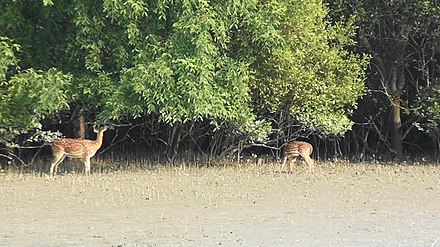
-
Ajodhya Hill and Forest Reserve Area 📍 — a low-lying hill in the Rarh region
-
Buxa Tiger Reserve — a forested area in Buxa and Jayanti Hills is a habitat for tigers, Asian elephants and other mammals plus a variety of birds, amphibians and reptiles
-
Gorumara National Park — rolling grasslands and forest is rich with herbivores such as the Indian rhinoceros and elephants birds, reptiles and amphibians
-
Gour — former capital of Bengal under the Sultans
-
Jaldapara National Park — a national park with wildlife including one-horned rhinos
-
Sagar Island — a Hindu pilgrimage site with unspoiled beaches
-
Santiniketan 📍 — the town of Rabindranath Tagore's university Visva Bharati and known for exotic handmade goods
-
Singalila National Park — a popular trekking destination with Mt Sandakphu, the tallest peak of West Bengal
-
Sundarbans National Park — a with Royal Bengal Tigers and deer found in forests and mangrove swamps
Understand
Name
The term "West Bengal" is originated during the partition of India in 1947, as the name of the Indian state carved out of the western parts of the former Bengal province. The remaining eastern parts of Bengal joined with Pakistan from 1947 till 1971, when it became Bangladesh. However, the exact origin of the word "Bengal" is uncertain (see Bengal#Name).
History
.jpg/440px-Lukachuri_Gateway_(4).jpg)
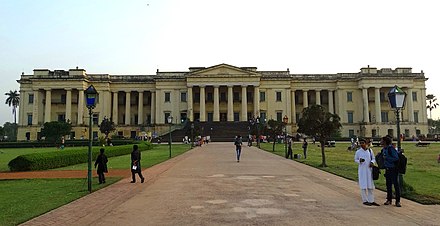 The history of West Bengal dates back to 20,000 years. The region that is now West Bengal was part of a number of empires and kingdoms during the past two thousand years, including the Vanga Kingdom, the kingdom of Magadha. However, the first independent king of Bengal was Shashanka of the 6th century, with his capital at Karnasuvarna (near present-day Baharampur). After Shashanka, Bengal was ruled by Pala and Sena dynasties. Bengal was later invaded by Rajendra Chola I of the Chola dynasty between 1021 and 1023.
The history of West Bengal dates back to 20,000 years. The region that is now West Bengal was part of a number of empires and kingdoms during the past two thousand years, including the Vanga Kingdom, the kingdom of Magadha. However, the first independent king of Bengal was Shashanka of the 6th century, with his capital at Karnasuvarna (near present-day Baharampur). After Shashanka, Bengal was ruled by Pala and Sena dynasties. Bengal was later invaded by Rajendra Chola I of the Chola dynasty between 1021 and 1023.
During the 12th century, Sufi missionaries arrived in Bengal, bringing along with them the message of Islam. Bakhtiar Khilji, a military commander from the Delhi Sultanate, overran Bengal between 1202 and 1206, initiating the Bengal Sultanate that ran from 13th to 16th century, with the capital being Gour-Pandua. European traders arrived late in the 15th century and established settlements across the Hooghly River.
Bengal was later conquered by the Mughals in 1576. There were several independent Hindu states established in Bengal during the Mughal period like those of Maharaja Pratapaditya of Jessore and Raja Sitaram Ray of Bardhaman. The Koch Bihar Kingdom in North Bengal flourished during the 16th and 17th centuries. The Mughal Bengal was ruled by Nawabs in early 17th century, with the first Nawab of Bengal being Murshid Quli Khan.
The Battle of Plassey in 1757 saw the defeat of Siraj ud-Daulah, the last independent Nawab of Bengal. Bengal Presidency was established by 1765, eventually including all British territories north of the Central Provinces (now Madhya Pradesh and Chhattisgarh), from the mouths of the Ganges and the Brahmaputra to the Himalayas and the Punjab region. Calcutta was named the capital of British India in 1772. The Bengal Renaissance and Brahmo Samaj movement had a great impact on the cultural and economic life of Bengal. The failed uprising against the British rule in 1857 resulted in the disbandment of the British East India Company.
Between 1905 and 1911, attempts were made to bifurcate Bengal to curb nationalism, but widespread protest forced the British to call it off. Bengal played a major role in the Indian independence movement, producing some of India's greatest revolutionaries including Netaji Subhas Chandra Bose. At the independence of India in 1947, Bengal was partitioned along religious lines, with the western part remained in India as West Bengal while the eastern part joined Pakistan as East Bengal (present-day Bangladesh). In 1950, the Cooch Behar State merged with West Bengal. In 1955, the former French enclave of Chandannagar was integrated into West Bengal.
Incidents surrounding the Bangladesh Liberation War of 1971 caused millions of refugees to influx into West Bengal, most of them Hindus. The Left Front, led by the Communist Party of India (Marxist), governed the state for the subsequent three decades, making it the longest-serving democratically elected communist party in the world. Although they are no longer in power since 2011, the Communists' imprint remains powerful on the state, with many streets named after Marx and other local and foreign revolutionary figures.
Geography
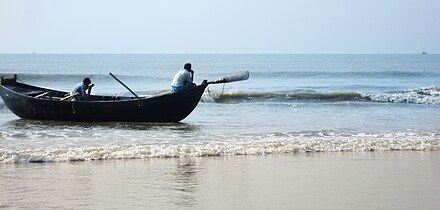 West Bengal is diverse in terms of geography and is distinctively unique for being the only state in India with the Himalayas in the north and the Bay of Bengal in the south, with vast stretches of plains, plateaus and deltas between them.
West Bengal is diverse in terms of geography and is distinctively unique for being the only state in India with the Himalayas in the north and the Bay of Bengal in the south, with vast stretches of plains, plateaus and deltas between them.
The Eastern Himalayas range starts abruptly up from the Terai region near Siliguri. Sandakphu at is the highest point of West Bengal. Remnants of the Shivaliks can be seen on the northern plains, where they are known as the Buxa-Jayanti Hills. The Terai is a belt of marshy grasslands, savannas and forests at the base of the Himalayas range. The Dooars region stretching across the middle of the Terai belt are a conglomerate of tall grasslands, savannas and evergreen and deciduous forests.
The Rarh region lies south of the Ganges and east of the Chota Nagpur Plateau, the eastern part of which is in West Bengal. Part of the Sundarbans is in the vast deltaic region south of the state.
Culture
The culture of West Bengal attracts tourists from around the world. It has its roots in literature, music, fine arts, drama and cinema. Certain regions in the state are known for their folk cultures as well.
Economy
West Bengal is the economic and transport hub of Eastern India and it is the home to some of the busiest railway stations in India. The state also has river ports at Kolkata and Haldia. Kolkata is an information technology (IT) hub of the state, with several IT firms and companies having established their campuses in the city.
Climate
West Bengal experiences 5 seasons: spring, summer, monsoon, autumn and winter.
Spring is short and more dominant in the northern region. Summer commences from the first week of March and continues till June. The weather remains hot and humid during the day, accompanied by cool breezes at night. The western highlands will experience a hot dry climate. Thunderstorms locally called Kalbaishakhi, occur in late summer. Monsoon starts in July and ends in late September when torrential rainfall gives rise to severe floods in the south. Autumn is short, between October and mid-November. The retreating monsoon at this time may give rise to storms. Winter sets by late November and continues till Spring arrives in February, January being the coldest. The Himalayan region in the north experiences snowfall during winter, usually after mid-December.
In the plains, during summer the temperature ranges between 26 °C (79 °F) and 40 °C (104 °F) while winter experiences between 13 °C (55 °F) to 19 °C (66 °F). The Darjeeling Hills have an average temperature of about 15 °C (59 °F) during summer and 2 °C (36 °F) during winter.
North Bengal receives the highest rainfall, while Rarh receives the lowest rainfall. Coastal regions receive medium rainfall. Drought-like conditions may occur in Purulia.
Talk
The official languages of the state are Bengali and English.
Nepali is widely spoken in the Darjeeling Hills.
Hindi is spoken in major cities, and you're likely to find a Hindi speaker in Kolkata.
Other commonly spoken languages include Santali, Odia, and Urdu.
Get in
Kolkata is considered to be an ideal hub to cover all the destinations in West Bengal and there are several public transport services to and from the city.
By plane
Travellers from abroad might certainly come in via Kolkata. Besides, a few major cities have domestic airports.
-
Netaji Subhas Chandra Bose International Airport (IATA: CCU), Dum Dum, Kolkata, +91 33 2511 8036 , +91 33 2511 8787 , +91 33 3987 4987
-
Bagdogra International Airport (IATA: IXB), Bagdogra, Siliguri, +91 353 269 8431
-
Kazi Nazrul Islam Airport (IATA: RDP), Andal, Durgapur, +91 99333 07863
-
Cooch Behar Airport (IATA: COH), Cooch Behar
By train
Railways link it with other states from all sides. Major railway stations are in Asansol, Howrah, Kolkata and Siliguri.
By bus
Government-owned companies like NBSTC (North Bengal State Transport Corporation), SBSTC (South Bengal State Transport Corporation) and WBTC (West Bengal Transport Corporation) operate buses to and from various destinations within Eastern India. Several private players also operate air conditioned buses between most important destinations. You can book a bus tickets online for government buses via official websites of respective companies, and for private buses you have options like Redbus, Abhibus, MyTempoTraveller and Myticketbuddy (dead link: January 2023).
By car
Kolkata is one of the vertices of the Golden Quadrilateral project, a network of highways that connect the major cities of India. All other major cities are also well connected by national and state highways.
By boat
Major ports are Kolkata and Haldia, and there are some smaller ports.
Get around
Within the state, the main transport links are trains and buses. Taxis and hired cars are available in most places.
By train

The southern part of West Bengal is served by the Kolkata Suburban Railway (commonly referred to as "local trains"). Depending on the route, local trains can be extremely crowded. It is less expensive to travel around by train as compared to private cabs or taxis.
By rickshaw
Rickshaws are the most common mode of transport in West Bengal, especially for short and medium distances. There are three types of rickshaws operating throughout the state: cycle rickshaws, electric rickshaws (locally called totos) and auto-rickshaws (locally called autos). Electric rickshaw operators can charge huge fares on seeing a tourist. Usually, electric rickshaw rides are short and cost ₹10-15 per person (as of 2022).
By car
There are highways and expressways connecting the cities and other adjacent states. There is almost no traffic except during the festival season, and even then traffic is reasonably light. All villages are connected via paved roads. You are required to pay toll taxes at various points on the expressways and national highways through FASTag. Charges may vary depending on the type of vehicle.
See
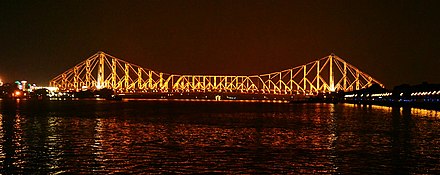
 The state of West Bengal has significant architectural and natural heritage. The Howrah Bridge, the Victoria Memorial and Vidyasagar Setu symbolises not only Kolkata but also the entire state. Although Kolkata may have the lion's share of the state's museums and landmarks, you should not ignore the rest of West Bengal. There are numerous cities, villages and national parks spread across the state.
The state of West Bengal has significant architectural and natural heritage. The Howrah Bridge, the Victoria Memorial and Vidyasagar Setu symbolises not only Kolkata but also the entire state. Although Kolkata may have the lion's share of the state's museums and landmarks, you should not ignore the rest of West Bengal. There are numerous cities, villages and national parks spread across the state.
Historical attractions
West Bengal was the cultural centre of India during the British rule. Monuments and places of worship in the state had been influenced by several cultures and their distinct architecture also speaks of the time of their construction. British influence had led to the construction of many buildings featuring European style architecture, few noteworthy of them carries a Gothic influence.
Natural attractions
The natural beauty of West Bengal is diverse, from the snowy Darjeeling Hills at the north to the Bay of Bengal and the Sundarbans at the south. The coastal strip of West Bengal, from the Sundarbans to the border of Odisha, has some beautiful beach resorts, including Digha, Shankarpur, Mandarmani, Bakkhali and Sagar Island. The Chota Nagpur Plateau at the western fringe of the state is also incredible with low-lying hills and other picnic spots.
Itineraries
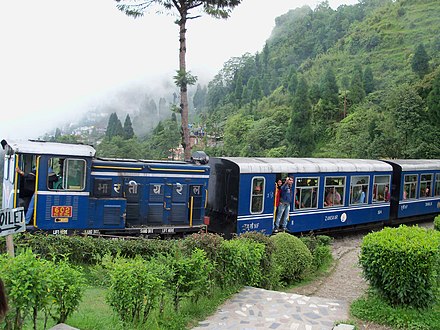
- Darjeeling Himalayan Railway (Toy Train) — a narrow-gauge heritage railway service from Siliguri to Darjeeling, run by the Indian Railways. It was built between 1879 and 1881 and is about 86 km long. It is powered by steam and diesel engines and offers panoramic views while climbing up the mountains. Listed as a , this route is popular with tourists as it passes through picturesque mountain scenery.
- Grand Trunk Road — its main route starts from Howrah and runs across the Hooghly River before turning northwest into the Rarh region.
- Sandakphu–Phalut Trek — Sandakphu (3,636 m) is the highest point in West Bengal and Phalut (3,600 m) is the northernmost point of West Bengal. The trek combines both these points offering great views of Kangchenjunga and several other snow peaks including Mount Everest.
Do
West Bengal has numerous independent theatre groups locally called jatra dôl (travelling group/band), who perform shows mostly in the rural areas. Foreigners not familiar with the dialect spoken can enjoy the atmosphere surrounding these events, as fairs organised by local inhabitants, merchants and craftsmen often accompany such gatherings.
Make an adda with people. Adda is a term Bengalis use for freestyle intellectual verbal information sharing. It is a common sight in Bengal to find groups engaged in rigorous discussion and debates, though more notably in Kolkata. Such gathering always welcome anyone who wishes to join them. It offers a great opportunity to learn more about the local customs, the people and their views on different things and happenings in and around West Bengal. People from various age groups will happily invite foreign tourists to join their discussions and share thoughts, ideas and experience.
Take a boat ride across the Hooghly River, or hire a small boat and spend the evening discovering the banks of the river around Kolkata, Howrah, Diamond Harbour, Chandannagar or Murshidabad. Boatmen usually demand ₹500 for an hour. Price is negotiable through bargaining.
Events
Baro Mase Tero Parbôn
It is a Bengali proverb which literally translates to "thirteen festivals in twelve months". Numerous festivals are celebrated in West Bengal, which can be religious, social, cultural or national ones.
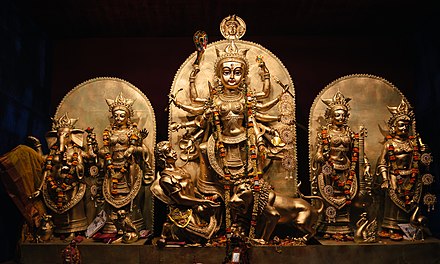 Durga Puja is the most celebrated festival in West Bengal. It takes place between September and October, depending on the Hindu lunisolar calendar. There are celebrations in every corner of the state. People are filled with joy and happiness. People distribute sweets and clothes to their loved ones, expressing love and joy. Durga Puja in Kolkata has been listed as a UNESCO Intangible Cultural Heritage in 2021.
Durga Puja is the most celebrated festival in West Bengal. It takes place between September and October, depending on the Hindu lunisolar calendar. There are celebrations in every corner of the state. People are filled with joy and happiness. People distribute sweets and clothes to their loved ones, expressing love and joy. Durga Puja in Kolkata has been listed as a UNESCO Intangible Cultural Heritage in 2021.
Celebrelated at the day of Diwali, Kali Puja is another major festival in West Bengal, worshipping the Goddess Kali.
Ras Mela is one of the most famous and popular yearly fairs in the entire state of West Bengal. Ras Mela is hosted in the occasion of Ras Purnima and the city is fully decorated. Conducted in a huge open ground, it is full of people. You can enjoy food, rides, circuses and many more. There could be some issues entering the fair as the entry points are totally jampacked but once you are in the fair, you can enjoy the rest of your night. There are singers and performers coming from different parts of India. There is an atmosphere of enjoyment and craziness in this time of the year. It's like a winter carnival. Mostly organised in late November or early December. Dates can change each year as it is organised on the basis of a Hindu astronomical event, Ras Purnima or Shakta Rash.
Beside religious festivals, Poila Boishakh (Bengali New Year) is also celebrated in West Bengal. Here people from all walks of life participate in various cultural shows, called Boishakhi Mela, wearing the national attire (punjabi or sari), eating Bengali sweets and wishing everyone a happy Bengali New Year.
Eat

West Bengal is famous for fish preparations and sweet meat but some of the vegetarian dishes are also a speciality. In earlier centuries widows were prohibited from taking anything other than vegetarian food (predominantly they still are but now rules are being broken) and they were principal chefs in large homes. They developed vegetarian dishes extensively.
Bengali cuisine is centred around fish. Machher jhol, fish in curry gravy, is a watery fish curry available everywhere and goes well with rice. However, Bengalis everywhere swear by ilish (aka hilsa, a variant of shad), which is lightly marinaded in mustard and steamed is up there with the best fish dishes in the world.
West Bengal is known to make distinctive sweetmeats from milk products, including rôsogolla (aka rasgulla, cheese balls dipped in a sugary syrup), pantua (a fried variant of rôsogolla) rôsomalai (aka rasmalai, cheese balls dipped in creamy sweetened milk), chômchôm, kalojam, mishti doi (sweet yoghurt) and several kinds of sôndesh. These sweets are also famous all over India. Pitha, a kind of sweet cake, bread or dimsum are specialties of winter season. Sweets like narkel-naru, til-naru, moa and payesh are prepared during the Lakshmi Puja. Popular street food includes alur chôp, begunī, jhal muri (similar to the bhel puri of Mumbai) and phuchka (aka golgappa).
In cities like Kolkata, one can get all types of food from any part of the country. Even one can get Chinese, Thai and continental. In most of the other towns, one can mostly find Bengali hotel and restaurants, though Punjabi, North Indian and South Indian outlets are also available. Mughlai dishes are very popular.
Drink
There are plenty of bars across the state. You might expect nightlife in major cities like Kolkata and Siliguri.
Sleep
Like the rest of India, there are both government and private accomodations. Most of the government lodges are run by the West Bengal Tourism Development Corporation (WBTDC or West Bengal Tourism) and can be booked from the tourism centres in Kolkata and Siliguri.
Stay safe
West Bengal is very safe for foreigners. People are friendly and accept people of different cultures warmly. As a foreigner you might find people staring at you but they are just curious. But if you notice anything objectionable in their behaviour with you, face them boldly and ask for help. People are helpful and you will have them coming to your rescue. You may also call the police. But people on the roads are helpful to foreigners and they can be relied upon.
West Bengal is a very politically active state. You may witness clashes, which most often occur between students of fronts affiliated to the ruling party and the opposition parties. It is better to stay out of the matter and leave the area, as even the police sometimes get involved.
You should take extra precautions while travelling closer to the India–Bangladesh border. There have been cases of illegal migration of people from Bangladesh and drug dealings along the border are fairly common. You might take the assistance of the Border Security Force (BSF) if necessary.
Natural disasters
The southern parts of West Bengal are prone to flooding, since the areas are composed mainly out of silt, a material which is carried down by the rivers and tributaries comprising the Ganges Delta. The rivers would overflow or burst their banks after heavy rainfall. Also, beware of the cyclones occurring at the coastal areas of the state.
The Darjeeling Hills experience heavy rainfall as well, with moderate snowfall in winter. Altitude sickness is another problem in the region.
Respect
Although West Bengal has a lot in common with Bangladesh, don't treat it as a part of Bangladesh, It can be considered offensive.
The Indian rupee is commonly called taka in West Bengal. You must not confuse it with the Bangladeshi taka.
The various respect tips in the Bangladesh article apply here, except that the state is Hindu-majority.
